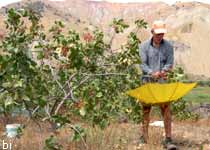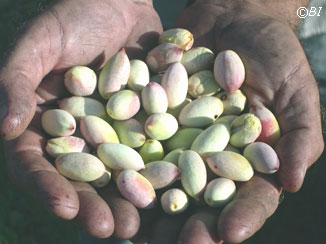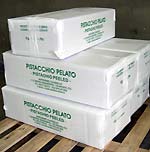Bronte's Pistachio
The Picking  The brontese pistachio picking is two-yearly and is carried out in the uneven years, towards the end of August and the start of September. The brontese pistachio picking is two-yearly and is carried out in the uneven years, towards the end of August and the start of September.
Each plant produces from 5 to 15 Kg of tignosella (so is called the fruit when peeled and dried) with maximum peaks of 20-30 Kg.. On the even years, when there is no picking, is carried out what is called the green pruning: the flowering buds in the extensions of the previous year are removed by hand.
The green pruning is a tradition that goes back to earliest times - probably to the Arab domination period - and that is handed down from father to son without a continuity solution. Testimony of a culture, the peasant one, according to which, thanks to the "rest", the plant can absorb from the rocky land the necessary substances to produce a fruit richer of fragrance and full of unmistakable flavors. Every two years (the uneven ones) over 30 thousand quintals of pistachios are picked in Bronte.  That represents just the 1% of the world production, but, for our town, represents the most significant economic element both for the surface interested in such cultivation and for the relevant value of the production. That represents just the 1% of the world production, but, for our town, represents the most significant economic element both for the surface interested in such cultivation and for the relevant value of the production.
Also because of the impervious and steep environment in which the plant is grown, the danger of dispersion of the fruit among the "sciarelle" of the "lochi", the harvest involves a considerable use of expensive labor. It is still done entirely manually directly from the trees by dropping the fruit into a container carried on the shoulder or shaking the branches to collect the fruit on sheets spread at the foot of the plants or, in some cases, even with the curious but practical use of an upside-down umbrella hanging from the branch. A quick game of patient hands stained by the abundant resin of the branches, a long-awaited celebration and effort, in which the whole family participates with different tasks, including women, grandparents and children. After the picking the fruit, by mechanical rubbing, is"sgrollato" (separated fromits leathery cover) and dried for 3-4 days in the sun, in large open spaces prepared in front of the farm-houses.  This way is obtained the pistachio in its shell, locally called Tignosella, kept by the producers, before selling it, in dark and dry rooms. After two years of work and of spending a lot of money the producer's toil is finished. This way is obtained the pistachio in its shell, locally called Tignosella, kept by the producers, before selling it, in dark and dry rooms. After two years of work and of spending a lot of money the producer's toil is finished.
But because of a too low price or of a scarce crop, often it is not possible to recover the relevant cost of financial and physic energies. The last year (2000), for instance, for the adverse climatic conditions, 60% of the crop was lost. The shelling of the pistachio seed is done mechanically by the cooperatives or the local merchants to whom the product is sold or conferred. Up to some past decades the shelling was still done manually in the producers houses: with infinite patience and a rudimentary technique consisting in a block of lava rock, emptied inside, ("u sciffu"), onthe edges of which the pistachios, one by one, were hit and broken with hammers or stones.  Today the biennale work of the producers stops with the "tignosella" (the unshelled pistachio): for the shelling and peeling the fruit is brought to centers of collections or sold directly to exporters. Such processing is required by importing countries and confectionery and canning industries. In fact, just because of its bright green color (a true trademark), the brontese pistachio is commercialized nearly exclusively as "peeled". Today the biennale work of the producers stops with the "tignosella" (the unshelled pistachio): for the shelling and peeling the fruit is brought to centers of collections or sold directly to exporters. Such processing is required by importing countries and confectionery and canning industries. In fact, just because of its bright green color (a true trademark), the brontese pistachio is commercialized nearly exclusively as "peeled".
The peeling, removal of the thin purple-reddish pellicle is done by a highly technologic process which exposes the fruit to a brief jet of high pressure steam that causes the separation of the skin. A following passage to the peeling machine that, by rubbing of the rollers at differentiated speed, removes the pellicle. The green pistachios then go through a complex drying process at low speed and from this to an electronic selecting machine that rejects eventual pistachio of not the right color. The product now dry (with a humidity of 4-5%) is wrapped up in cartons of 12,5 Kg.. The processing cycle is now concluded. In ambient fresh and dry the product preserves its color for several months, and then starts fading.  That is why the Cooperatives and the exporters peel their pistachios only to order and don't keep stock of "peeled pistachio" as this, before being peeled, can be kept in cold store for over a year without loosing any of its peculiarities. That is why the Cooperatives and the exporters peel their pistachios only to order and don't keep stock of "peeled pistachio" as this, before being peeled, can be kept in cold store for over a year without loosing any of its peculiarities.
Two years of hard work and long wait have gone by, but the result is the precious pistachio of Bronte, emerald green in color and rich of unmistakable, perceptible qualities. The intense green color of the cotyledons, the elongated shape, the aromatic taste and the high content of unsaturated fat acids of the fruit, are not easily found in the product of other areas. That determines a net preference towards product of American or Asian origin that presents, for the great part, roundish and yellow seeds, or not completely green and often yellowish, due to diverse climatic conditions, even if its price is always lower respect to the brontese product.
|